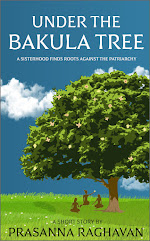A Book Review-The Daughters of Madurai by Rajasree Variyar.
Blurb:
Madurai, 1992. A young mother in a poor family, Janani is told she is useless if she can't produce a son--or worse if she bears daughters. They let her keep her first girl, but the rest are taken away as soon as they are born and murdered. But Janani can't forget the daughters she was never allowed to love.
Sydney, 2019. Nila has a secret she's been keeping from her parents for too long. Before she can say anything, her grandfather in India falls ill, and she agrees to join her parents on a trip to Madurai. Nila knows very little about where her family came from or who they left behind. What she's about to learn will change her forever. While The Daughters of Madurai explores the harrowing issue of female infanticide, it is also a universal story about the bond between mothers and daughters, the strength of women, and the power of love in overcoming all obstacles.
The story, in a nutshell.
A poor woman in India, Janai, bearing the social label of being born into a lower caste, suffers all odds, including the ridicule of bearing girl children and their murders and the overt and covert attempts of all people related to her to murder the girl child she wants to keep, in the end, lands in a different country and lives a better life.
These are the points I readily appreciate in Daughters of Madurai.
👍The book Daughters of Madurai sets forward a superbly relevant theme in the Indian context of female infanticide, the outcome of the low value assigned to girls and women compared to boys and men. Once done without raising any qualms, it now happens behind the scenes. The book fictionalises how it happened in Madurai, Tamilnadu, in 1992. The idea of a mother trying to save her daughter from all her slayers is promising. For the readers, it has a chance to act as a life simulation.
👍The description of the locations. The story happens in two timelines. The past timeline starts in 1992, and the contemporary timeline begins in 2019. The former part happens at Usilampatti, where Janai, the main character, lives with her inlaws- her Mamiyar (mother-in-law), her husband, who is only his mother's toy, and her daughter. Her Mamiyar practices her social/cultural rights to ravage the daughter-in-law being abusive, physically and verbally and to poison her to kill the child she carries. By the time you depart Janani at the end of the first timeline, you get a clear picture of the rustic vibe of life in the village, its landscape, and the daily drill of the women folks starting earlier than the sun shows up, the tasking chores in the kitchen, labouring in the paddy field, child care and of the bustling road root that Janani took one day to Madurai Meenakshi temple, it's awe-inspiring inside and outside, the crowd moving in one mind to beg for the benevolence of the idol, the vendors, their displays and the goodies and the flowers and the sweet, temple prasad. Janani took the time to pray for the blessing of a boychild. Also, we feel the sweltering day in Sydney and the route Nila takes daily to ease her daily tension.
How could the novel Daughters of Madhurai have been made better?
👎Secrets are the best bet to keep the readers' anxiety levels sharp and invested in books. The story promises two secrets. In the contemporary timeline, Nila is about to reveal her secret to her parents when they make an emergency trip home to Madurai. The readers learn Nila's secret within the book's first few pages, but they wait for the drama when she reveals it to her parents. How Alas! When a few pages remained to end the story, she says, "I told them."
👎The character's arc is poor, showing no action. At the end of the first timeline, Janani leaves her home to live in a shop organised by Sanjay, her childhood buddy, in whose house she is a maid. In the contemporary timeline, the two live together as a man and a woman in Australia, Janani running a tailing course; no character action or the how part. The book shows the landscape and the locations but is not shown when it comes to characters; everything is simply told.
👎This book should improve in its technical perfection of story structuring. I guess this happens when the characters have no agency to take action. Making the characters without agency to carry out tasks/actions won't look real.
👎The character arc of Nila is also flawed. Living in Australia, she has the agency to take action and reveal her secret to her parents. But the story takes her to Madurai, where people throw at her distance, unfamiliarity, and lack of openness. There, the readers learn that she told her parents her secret—no height of tension, anxiety, drama, or aha moments.
👎Towards the end of the story, the narrative looks like reporting.
👎In a nutshell, given the prowess in describing the landscape and the location, the author could have presented a more impressive story, provided she had cared for narrative structure and story structuring.
My rating for The Daughters of Madurai is 3.25 out of 5.
This post is part of the Bookish League blog hop hosted by Bohemian Bibliophile.
This review post is also for #BookishLeague #12books12Recs.
This post is also for Blog Chatter #ReadingChallenge. #TBR
This blog post is part of the blog challenge ‘Blogaberry Dazzle’
hosted by Cindy D’Silva and Noor Anand Chawla
in collaboration with Dr. Preeti Chauhan.









56 comments
I have heard of this book before but never got down to reading it. Reading your review i shall pick it up soon.
ReplyDelete
DeleteIt's a highly promoted book, which made me go for it.
As you said, the characters lack action, it's a very good point to mention in your review so other readers could get an idea about the book matter. Though the story seems interesting, but i think if there would have some twists it could be made an interesting read. - Swarnali Nath (The Blissful Storyteller)
ReplyDeleteThe character should take the story forward, and if you read a book with that expectation and not met, you get disappointed especially when the book is credited with fame.
DeleteAfter reading your review, I am in two minds: to read or not to read. I like the core plot, but as you havementioned the narrative and the characterisation isn't great, am thinking.
ReplyDeleteThe book has a great central plot but is flawed in working it out.
DeleteA detailed critique Prasanna. You are correct about the characters having agency and the aha moments. They are what make a book compelling. P.s I think there is a typo in the end of the last line where you have mentioned the rating. Instead of Madhurai , it has been auto corrected to Madhira
ReplyDeleteHarishita, you have observed that very valid point about characters' agency—many thanks for pinpointing that typo. I have corrected it.
DeleteAs you have rightly pointed out, Story structure helps to guide audience from the beginning to the end of the book by introducing characters and settings, setting up the conflict, developing the main plot points, and finally resolving that conflict. It also helps create tension, suspense, and surprise—essential components of almost any story.
ReplyDeleteHi Anuradha, I always value your significant observations in your comments. Thank you.
DeleteWhat a wonderful dissection of the book " The Daughters of Madurai" by Rajasree Variyar.You have given a very honest opinion about the flaws and the highlights of this book. For me the title too does not work, it tells me nothing other than that it is based in Madurai and is probably women oriented.The cover doesn't appeal to me either.
ReplyDeleteOh, Preeti, those are great observations coming from you. I haven't noticed that point about the cover, but I was ok with the book's title.
DeleteWhat an insightful review of "The Daughters of Madurai" by Rajasree Variyar. You've given a thorough critique that highlights both the strengths and weaknesses of the novel, providing a balanced view that can greatly assist potential readers in setting their expectations.
ReplyDelete
DeleteHi, thank you so much for that appreciation. I hope I did it right to set the future readers' expectations about the book.
I see more negatives in your review that positives, which is probably why I won't opt for this book. One of the -ves also mentions how the reveals aren't well-timed and that for me is a major turn off because I like being surprised.
ReplyDeleteThank you for that observation. I wasn't negative but honestly analysing its value.
DeleteSuch a detailed, analytical review.
ReplyDeleteI have heard of this book.
A fictional story needs to have an arc. Recently, I left several books unfinished mainly because of this problem.
Thank you, Tarang. That is so unfortunate to keep the books you bougt out of love unfinished.
DeleteSo Mam you rated it 3.5/5 and for me its a very average rating for a book and even the plot didnt tempted me much I will prefer to give it a skip and I hope you wont mind.
ReplyDeleteMy rating is 3,25 /5. I rated it honestly rating it, and the decision based on that is strictly yours. Thank you. :)
Deletelove the way you have framed the review and i need my characters to have an evolutionary arc. I dont think I would be picking up this book anytime soon. might think about it.
ReplyDeleteThe decision is all yours. Thank you :)
DeleteThe plot sounds interesting, but the technical details — the things that make for a good reading experience — appear to be lacking. A pity, really!
ReplyDeleteThe plot was a catch, not how the author worked it out.
DeleteIt doesn't sound like a book I'd enjoy reading. So will skip it.
ReplyDeleteThe decision is all yours. :)
ReplyDeleteI appreciate your honesty and the way you dissected The book's pros and cons. It is great efforts to write about the book which is so popular with so much ease. Will definitely give it a try.
ReplyDeleteThank you. Give it a try and form your own opinion on it. :)
DeleteI have been planning to pick the book for the last time. Have my copy too. Reading your review, I'm not sure I will be picking it up anytime soon. On a lighter note, I don't envy reviewing the book as an author. It is as much difficult for me to critique an ad or graphic. The issues and errors just stand out, which might not for a regular reader/designer.
ReplyDeleteI should say, you should form your own opinion after reading it. We may differ in our opinion. Mine is based on the technical aspects of the story structure.
DeleteThanks for this review. Guess I would be skipping this. Your review had quite a few typos or missing link like :
ReplyDeleteHow Alas! When a few pages remain to end the story, she says, "I told them.
The sentence just hangs there
It is up to you to read or skip it. Perhaps your opinion might differ from mine.
DeleteNow, about what you construe as a typo. Let me give it verbatim
("I step out of Acha's arms.
I take a deep breath.
And I tell them.") The book is written from two points of view; Nila tells her story in the first person.
I hope that clarifies your doubt.
What a powerful review! "Daughters of Madurai" sounds like a poignant and important read, shedding light on the harsh realities faced by women and girls. Your thoughtful analysis has piqued my interest, and I’m adding it to my reading list. Thank you for highlighting this significant work!
ReplyDeleteThank you. Please read the book, review it and share it.
DeleteWhat a wonderful dissection of the book " The Daughters of Madurai" by Rajasree Variyar. I have been planning to pick the book since long and do give it a try. So, I really liked and appreciated your amazing in depth review and honesty about the plot. I would try to read it too.
ReplyDeleteThank you. Please do try to read the book and review it.
DeleteOh dear! It's horrible when highly promoted books fall flat, especially when we choose to pick them up because of the promotions. I've been caught in similar situations often (sometimes due to friends' recommendations too) and I hate it. I was intrigued by Madurai, a place I love, and I was hoping it was worth reading it. Thank you for your honest review.
ReplyDeleteI was also charmed by the hype it created through promotions, but I wanted to share my takeaway from it with the readers. As I have suggested in my review, it is worth reading for the details of its setting with Madurai.
DeleteSuch an honest review, Prasanna. The book lacks depth I think. An emotional topic of getting rid of a girl child has to be handled with great sensitivity and the emotions arising from it. You were not very happy reading the book I guess.
ReplyDeleteThank you. As I have mentioned, it has a worthy theme, but it slips in keeping the story structure intact, in my view.
DeleteFemale infanticide is a reality that's often brushed under the carpet. It's a tough subject to write on, so kudos to the author. That said, a book needs to be engaging to get the point across and from your review I feel it missed the bullseye. Can pick it up some time for its topic though.
ReplyDeleteOh! Yes, the theme is very topical and appealing, but keeping the technical side of the story structure cannot be compromised.
DeleteThe plot seems good. Gripping. But as I read your review you talked more on negative side. I think I will not read this book. There are very few author who post such true review. Appreciated 👍
ReplyDeleteThank you. Yes, it has a gripping theme, no doubt in that.
DeleteI’m intrigued by the dual timeline in "The Daughters of Madurai." It must add so much depth to the narrative, weaving together Janani’s struggles in 1992 and Nila’s journey in 2019.
ReplyDeleteOfcourse, the author has done justice in telling the story using two timelines.
DeleteSad but bitter truth. Female infanticide is still so much prevalent. The story line seems very intriguing. Would love to read the book.
ReplyDeleteThe theme is very topical. Please read it and review it.
DeleteThe book sounded interesting but if there is no character development, reading it will be disappointing. Thank you for sharing an honest review.
ReplyDeletePoor character development was exactly the isse that made me disappointed about the book.
DeleteAwwww... what a disappointment. When u started it I was expecting it to have all the elements and be an actual bestseller, but the negative aspects are way higher than the positive ones. But it was an honest review Prasanna and appreciate it.
ReplyDeleteI like the honest review. While the story looks interesting (my native place is Madurai and my grandmother was from Usilampatti), the way it is told seems to have flaws. How would you rate it on a scale of 5?
ReplyDeleteI admire you for this honest review. The plot is interesting as per your review but character building and some other aspects are weak. Should I pick up the book or not?
ReplyDeleteI was first hooked with the story then got lost. Too lost that my interest on this book review went sour. Apologies for saying this. Perhaps the book is confusing as well based on your rating so I can understand. - MommyWithAGoal
ReplyDeletesounds like an interesting book, and i enjoyed reading your review. i really like stories that are set in 2 timelines.
ReplyDeleteThanks for the honest and balanced review - I will probably avoid this one.
ReplyDeleteNoor
Post a Comment